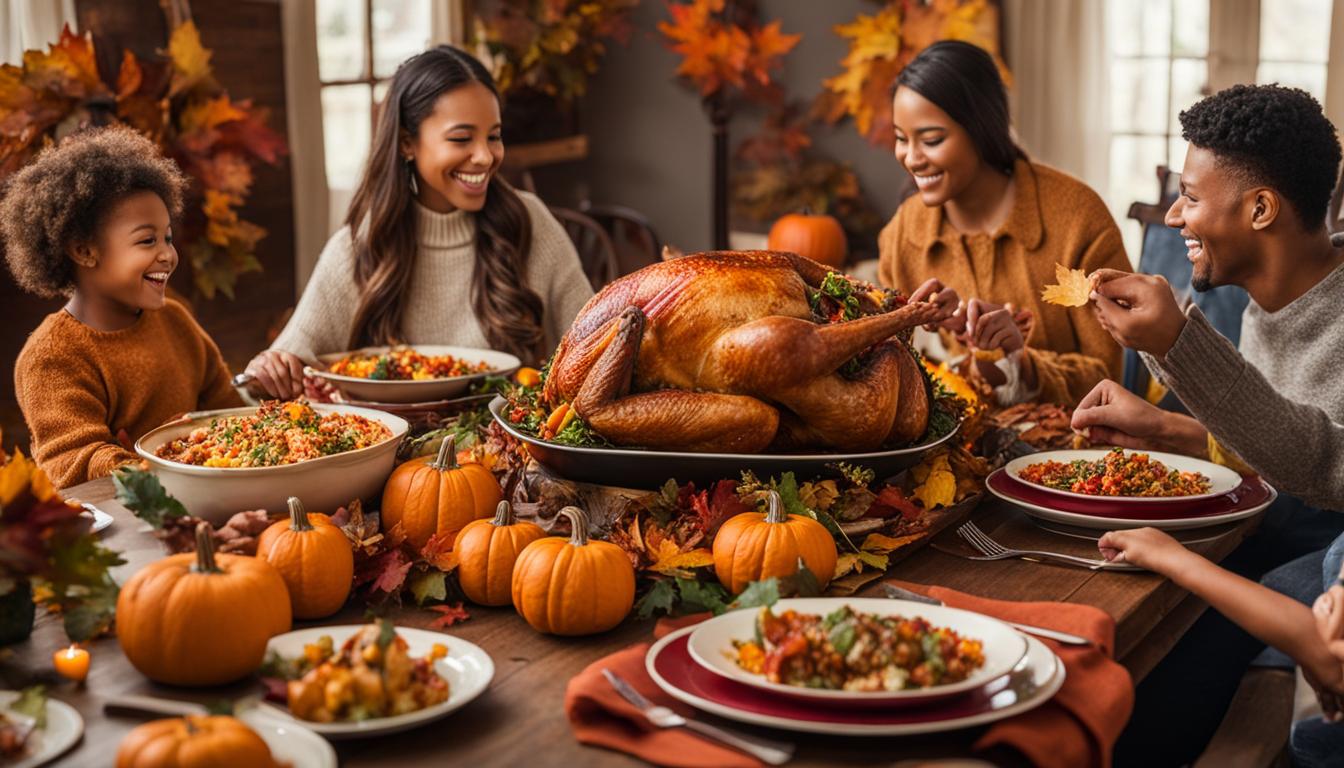Happy Thanksgiving Day 2023, everyone! Today, we are going to talk about the history of Thanksgiving and what it means to us today. Thanksgivings origins can be traced back to the 1621 feast between the Pilgrims and the Wampanoag Indians. This feast lasted three days, and it was held to celebrate the Pilgrims first harvest in the New World. The following year, the colony held another feast to celebrate their successful harvest. This feast became an annual tradition, and it eventually spread to other parts of the country.
Today, Thanksgiving is a national holiday in the United States and Canada. It is a day for family, friends, and food. We give thanks for our blessings, and we also remember those who are less fortunate. So let’s take a look at the history of this holiday and what it means to us today.
The first recorded Thanksgiving feast in North America took place in 1621. The Pilgrims, who had arrived in Plymouth, Massachusetts just the year before, invited the local Wampanoag Indians to join them in a three-day celebration of their first harvest. This feast consisted of wild game, fish, berries, and pumpkin. It was such a success that they decided to make it an annual tradition.
By the 18th century, other colonies had also begun celebrating Thanksgiving. Each colony had their own traditions, but they all involved giving thanks for a successful harvest. In 1777, the Continental Congress declared Thursday, November 26th as “a day of public thanksgiving and prayer”. This was also known as “the first Thanksgiving Proclamation”.
In 1863, President Abraham Lincoln declared that Thanksgiving should be a national holiday. He did this in an effort to unify the country during the Civil War. At first, only a few states observed the holiday, but by the end of the 19th century, it was celebrated by all states.
Thanksgiving Day wasn’t always about turkey and pumpkin pie. In fact, these foods were not even served at the first Thanksgiving feast! The Pilgrims were more likely to eat venison (deer meat), duck, goose, or rabbit. Pumpkin pie did not become a popular Thanksgiving dish until much later on.
So what does Thanksgiving mean to us today? For many people, it is a day to spend with family and friends, enjoy a delicious meal, and watch football. It is also a day to reflect on our blessings and give thanks for all that we have. We can also use this day as an opportunity to help others who are less fortunate. There are many ways to do this, such as volunteering at a local soup kitchen or donating food or clothes to those in need.
How will you be spending your Thanksgiving this year? Whatever you do, we hope you have a happy and safe holiday!
Thanksgiving Day is an American holiday celebrated (thanksgiving family holiday) on the fourth Thursday of November. It is a time when families and friends come together to give thanks and celebrate the blessings of the year. The traditions of Thanksgiving revolve around a shared meal, usually featuring a festive feast with dishes like turkey, potatoes, cranberries, and pumpkin pie. This holiday holds a special place in American culture, symbolizing gratitude, togetherness, and the spirit of giving.
Key Takeaways:
- Thanksgiving is an American holiday celebrated on the fourth Thursday of November.
- The centerpiece of Thanksgiving celebrations is a festive feast with traditional dishes.
- Thanksgiving is a time for families and friends to come together and express gratitude.
- The holiday symbolizes unity, togetherness, and the spirit of giving.
- Thanksgiving traditions include attending religious services and watching parades and football games.
The History of Thanksgiving Day
The history of Thanksgiving in America dates back to the early days of the country’s colonization. While most people associate Thanksgiving with the Pilgrims and their first celebration in Plymouth in 1621, there were earlier instances of giving thanks in the New World. In fact, English settlers in Virginia held a Thanksgiving feast in 1619 to commemorate their safe arrival in the colony. However, it wasn’t until the Pilgrims’ feast in Plymouth that Thanksgiving became deeply ingrained in American culture.
The Pilgrims, who were seeking religious freedom, arrived in Plymouth, Massachusetts, in 1620. After a challenging year that included loss, hardship, and the generosity of the Wampanoag tribe, the Pilgrims successfully harvested their first crops. To give thanks for their bountiful harvest, they organized a three-day feast, inviting the Wampanoag people to join them. This event is often regarded as the “first Thanksgiving” in American history, although it was not called that by the Pilgrims themselves.
“The event that Americans commonly call the ‘first Thanksgiving’ was celebrated by the Pilgrims after their first harvest in the New World in October 1621.”
Over the years, Thanksgiving became an annual tradition in some colonies, but it wasn’t until the 19th century that it became a recognized national holiday. In 1863, during the height of the Civil War, President Abraham Lincoln proclaimed Thanksgiving a national holiday, setting the date as the final Thursday in November. Since then, Thanksgiving has been celebrated as a time of gratitude, feasting, and togetherness, symbolizing the values that are deeply ingrained in American culture.
| Year | Significant Event |
|---|---|
| 1621 | Pilgrims and Wampanoag celebrate the first Thanksgiving in Plymouth |
| 1619 | English settlers in Virginia hold a Thanksgiving feast |
| 1789 | President George Washington proclaims a national day of Thanksgiving |
| 1863 | President Abraham Lincoln establishes Thanksgiving as a national holiday |
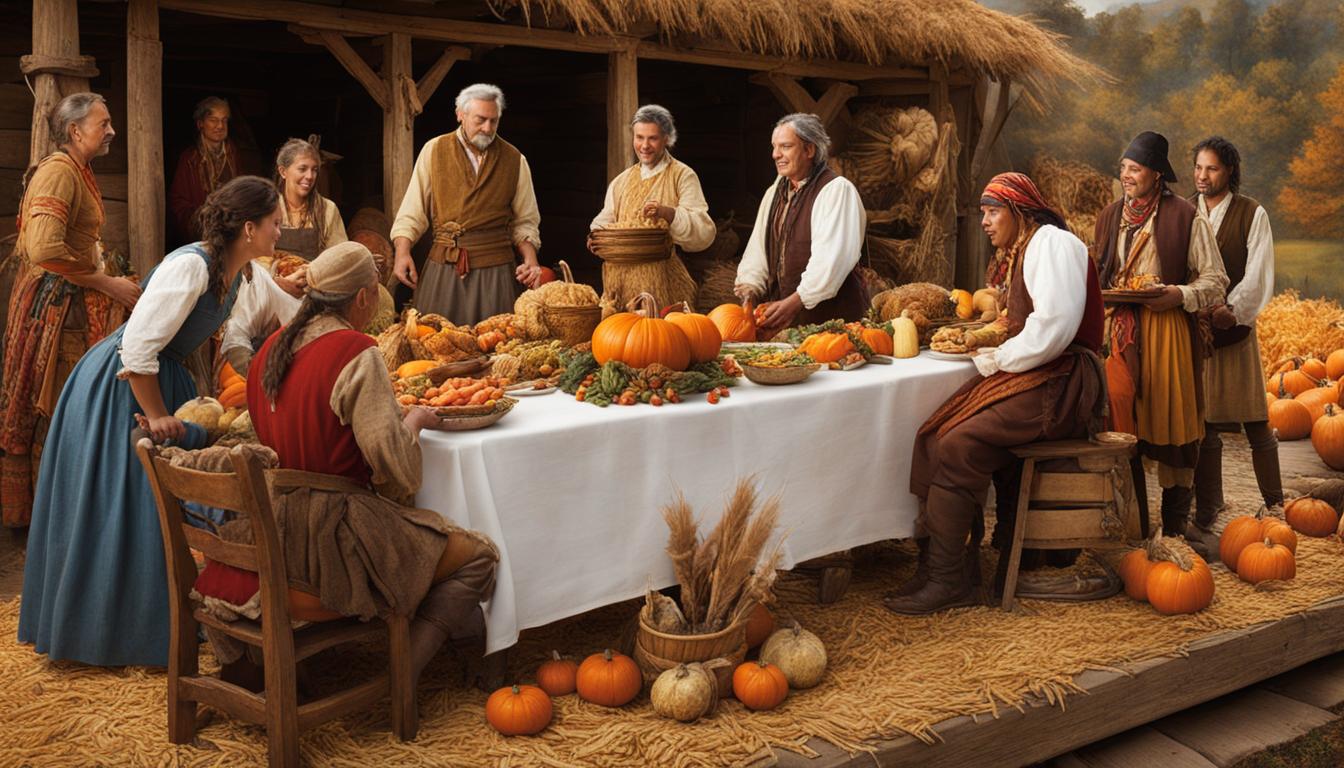
The history of Thanksgiving serves as a reminder of the importance of gratitude and coming together as a community. It is a time to reflect on the resilience and perseverance of the early settlers and to appreciate the abundance and blessings in our lives. As Thanksgiving continues to be celebrated across the United States, it carries with it the values and traditions that have been passed down through generations, reminding us of the rich history and diverse cultures that make America unique.
Thanksgiving Traditions
Thanksgiving traditions vary among families and regions but often involve giving thanks and spending time with family. Many families gather for a Thanksgiving meal, which typically includes a variety of dishes such as turkey, stuffing, cranberry sauce, and pumpkin pie. Some families also engage in activities such as watching football games, taking part in parades, or volunteering at charitable organizations. Additionally, some families have their own unique traditions, such as sharing what they are thankful for or participating in outdoor activities like hiking or playing touch football.
Table: Popular Thanksgiving Activities
| Traditions | Description |
|---|---|
| Gathering for a Thanksgiving meal | Families come together to enjoy a delicious feast, often featuring turkey and classic Thanksgiving dishes. |
| Watching football games | Many families enjoy the tradition of watching football games on Thanksgiving, whether it’s attending a local high school game or watching the NFL on television. |
| Participating in parades | Communities often organize parades on Thanksgiving, featuring floats and marching bands. Families may watch the parades in person or on television. |
| Volunteering at charitable organizations | Some families choose to give back to their community by volunteering at food banks, homeless shelters, or other organizations that provide support to those in need. |
| Sharing what they are thankful for | It’s common for families to go around the table and express what they are grateful for during the Thanksgiving meal, fostering a sense of gratitude and appreciation. |
| Outdoor activities | Some families enjoy spending time outdoors on Thanksgiving, whether it’s going for a hike, playing touch football, or taking a family walk after the meal. |
These traditions not only make Thanksgiving a special and memorable day but also reinforce the spirit of gratitude and togetherness that defines the holiday. Whether it’s enjoying a meal with loved ones, participating in community events, or creating unique family traditions, Thanksgiving is a time for reflection, connection, and appreciation.
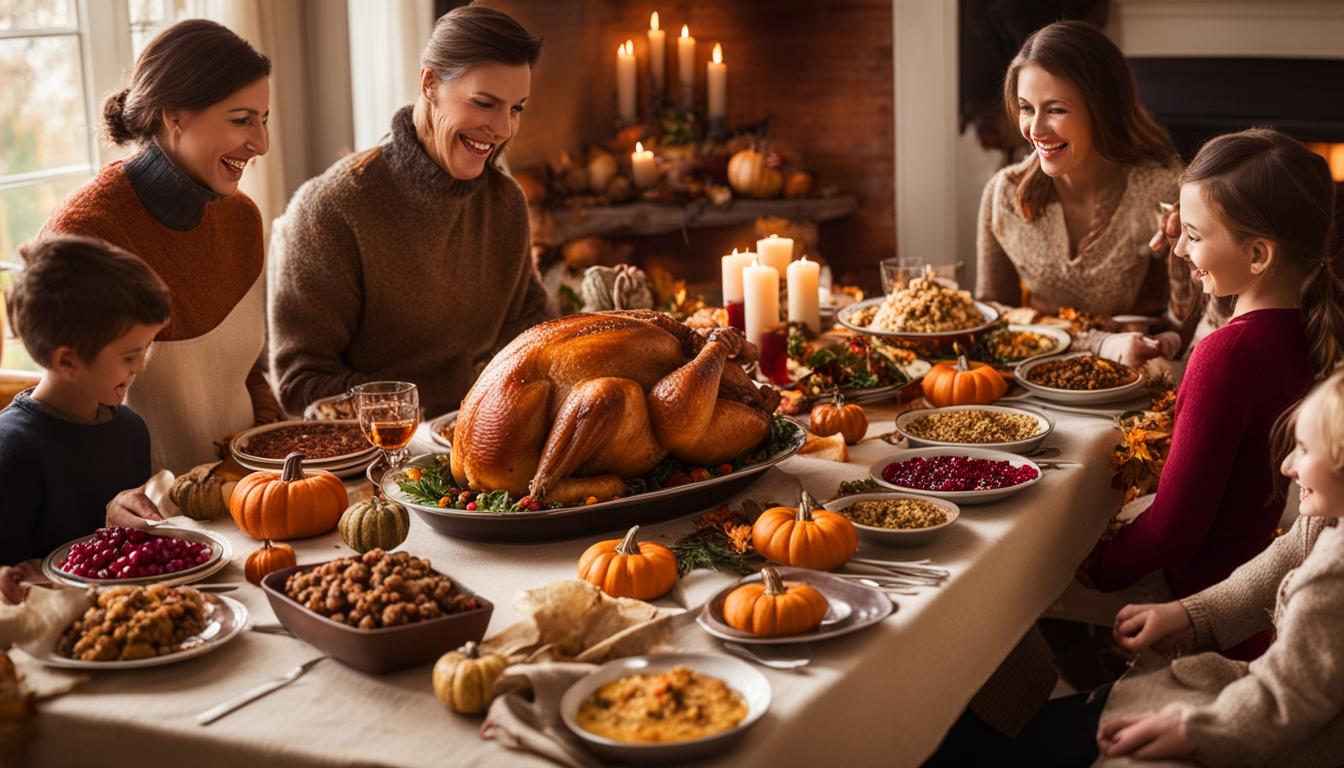
The Significance of Thanksgiving
Thanksgiving is a time to express gratitude for the blessings of the year and to come together as a community to celebrate. It is a day to give thanks for the harvest and for the abundance in our lives. The Thanksgiving feast is a central part of the celebration, symbolizing the abundance and generosity that we should be grateful for. It is also a time to reflect on the history of Thanksgiving and its significance in American culture.
Gratitude is at the heart of Thanksgiving. It is a day when we acknowledge and appreciate the people, experiences, and blessings that have enriched our lives throughout the year. From gathering around the table with loved ones to savoring a delicious meal, Thanksgiving provides an opportunity to express gratitude and to strengthen the bonds of family and community.
The thanksgiving feast is a time-honored tradition that brings people together to share a meal and to celebrate the abundance of the harvest. The table is set with traditional dishes such as roasted turkey, mashed potatoes, cranberry sauce, and pumpkin pie. It is a time to indulge in the flavors and aromas that evoke memories and create new ones. The feast is a tangible expression of gratitude and a reminder of the nourishment and sustenance that we are fortunate to have.
Thanksgiving holds a special place in American culture as a time for reflection, unity, and celebration. It reminds us of the importance of gratitude in our lives and encourages us to pause and appreciate the blessings that surround us. It is a day to come together as a community, to give thanks, and to share in the joy of the holiday season.
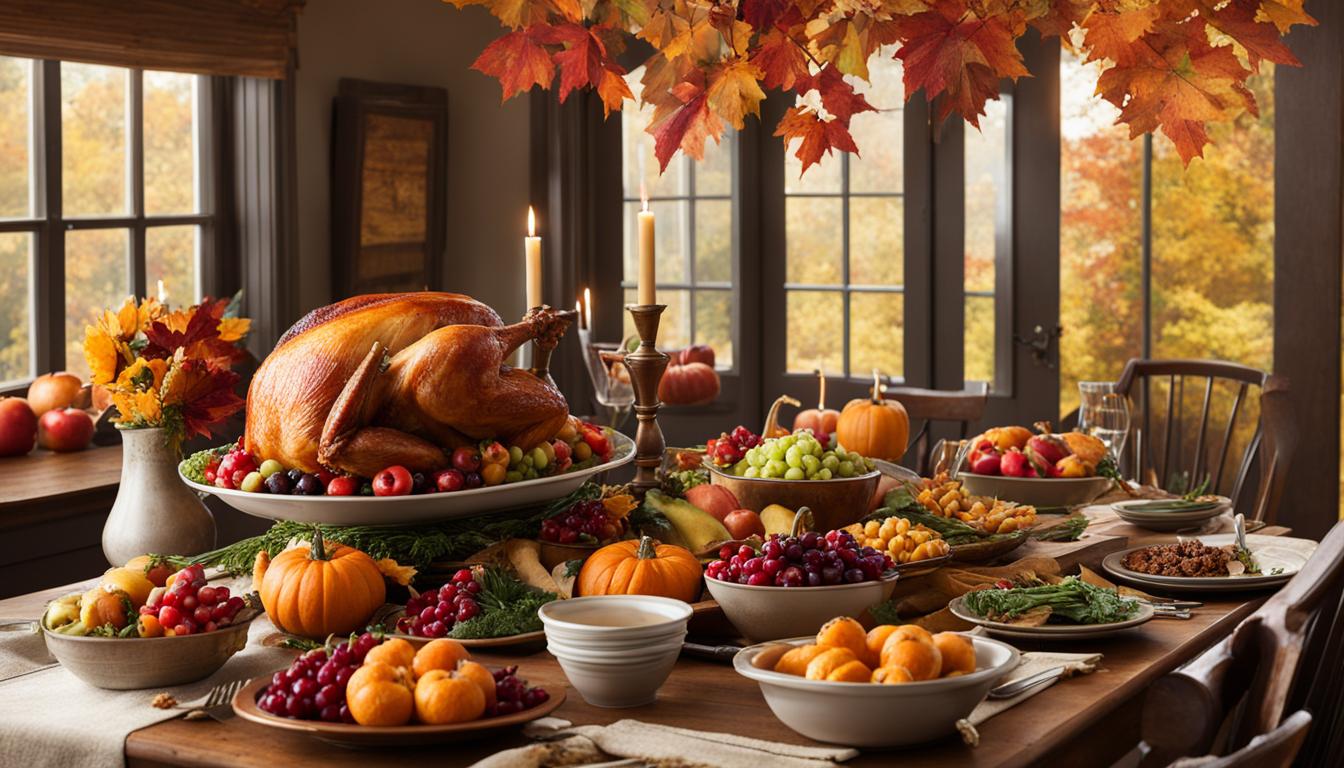
The Significance of Thanksgiving
| Traditions | Meaning |
|---|---|
| The Thanksgiving feast | Symbolizes abundance and generosity |
| Expressing gratitude | Recognizing and appreciating blessings |
| Family and community | Strengthening bonds and unity |
| Reflection and celebration | Pausing to appreciate |
Thanksgiving Recipes
One of the highlights of Thanksgiving is the delicious feast that brings families and friends together. Traditional Thanksgiving dishes are often passed down through generations, creating a sense of nostalgia and warmth. Here are some classic Thanksgiving recipes that will elevate your holiday dinner:
Roasted Turkey
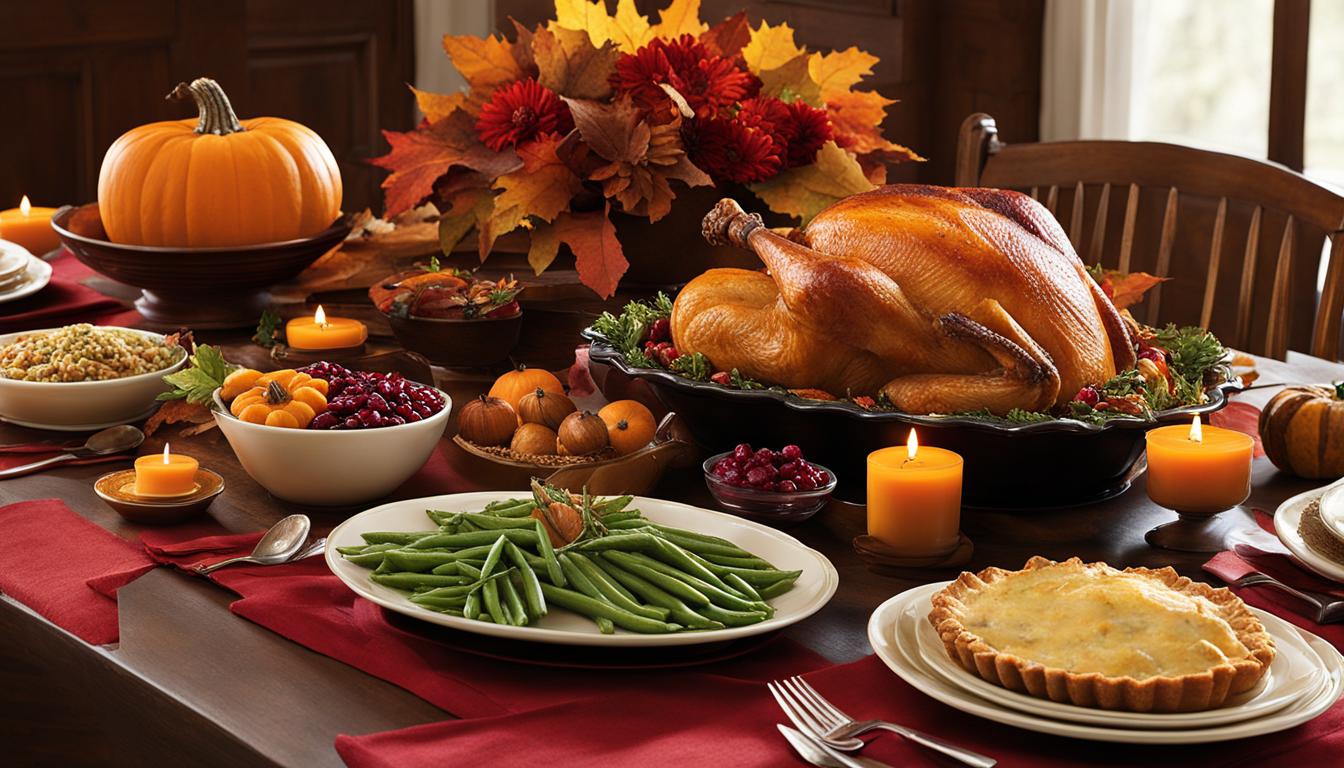
The star of the Thanksgiving dinner, a perfectly roasted turkey is a must-have on the table. Whether you prefer a brined, herb-rubbed, or stuffed turkey, the key is to achieve moist and tender meat with a golden crispy skin. Serve it with homemade gravy for that extra touch of flavor.
Mashed Potatoes
Creamy and fluffy mashed potatoes are a beloved side dish that pairs perfectly with turkey. Boil peeled potatoes until tender, then mash them with butter, milk, and seasonings. For an extra indulgent twist, add cream cheese or sour cream. Top it off with a dollop of butter and chopped fresh herbs.
Pumpkin Pie
No Thanksgiving dinner is complete without a slice of pumpkin pie. Made with a silky smooth pumpkin custard and a flaky crust, this quintessential dessert captures the essence of fall. Serve it with a dollop of whipped cream or a scoop of vanilla ice cream for a truly decadent treat.
These are just a few examples of the many delicious recipes that can grace your Thanksgiving table. Whether you stick to the classics or try out new variations, the key is to create a memorable meal that brings joy and gratitude to all who gather around it.
Thanksgiving Activities for Kids
Thanksgiving is a time for families to come together and celebrate with various activities that can engage and entertain children. These activities not only provide fun and entertainment but also help children learn about the history and traditions of Thanksgiving. Here are some enjoyable Thanksgiving activities for kids:
Thanksgiving Crafts
Get creative with Thanksgiving-themed crafts that children can make to decorate the house or give as gifts. Some popular craft ideas include making turkey handprints by tracing and cutting out hand shapes on colored paper, or creating paper plate turkeys using construction paper, googly eyes, and feathers. These crafts are not only entertaining but also allow kids to express their creativity and imagination.
Thanksgiving Games
Add some excitement to the Thanksgiving celebration with fun and interactive games for kids. A classic Thanksgiving game is the “pin the feather on the turkey” game, where blindfolded children try to place a feather in the correct spot on a turkey cutout. Another game idea is a Thanksgiving scavenger hunt, where children search for hidden Thanksgiving-themed items around the house or backyard. These games promote friendly competition and keep kids entertained during the holiday gathering.
Thanksgiving Activities for Kids
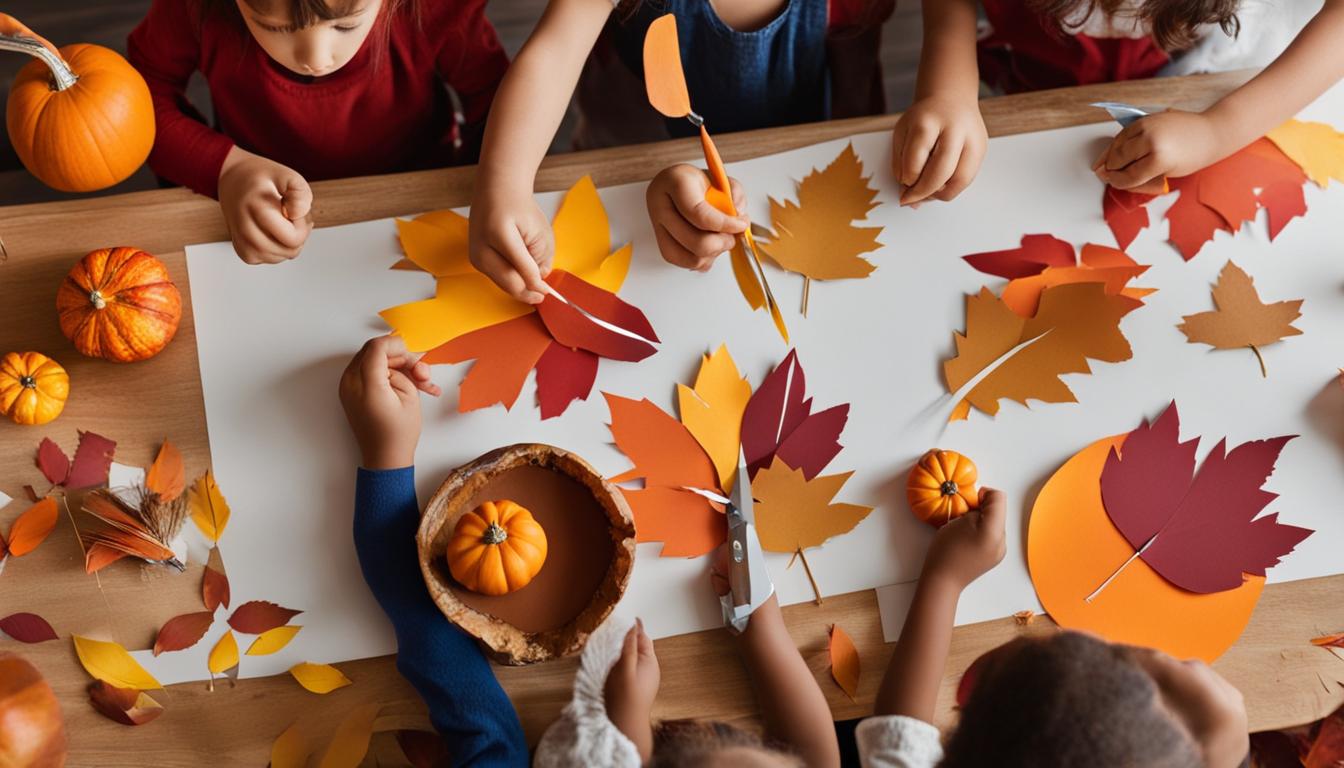
Engage children in educational activities that teach them about the history and traditions of Thanksgiving. For example, you can encourage them to create a Thanksgiving-themed collage using pictures and facts about the Pilgrims, Native Americans, and the first Thanksgiving celebration. Additionally, reading books about Thanksgiving or watching age-appropriate documentaries can provide children with valuable knowledge and insights about this important holiday.
By incorporating these Thanksgiving activities for kids into your holiday celebrations, you can make the day even more enjoyable and engaging for children. These crafts, games, and educational activities will not only entertain them but also help them appreciate the meaning and significance of Thanksgiving.
Thanksgiving Traditions in America
Thanksgiving traditions in America are diverse and reflect the rich history and cultural heritage of the nation. From gathering with loved ones to enjoying a special meal, the customs associated with Thanksgiving create a sense of unity and gratitude. These traditions have evolved over time, influenced by regional differences and personal preferences, but they all contribute to the celebration of this cherished holiday.
“Thanksgiving, after all, is a word of action.” – W.J. Cameron
Family Gatherings
One of the most cherished Thanksgiving traditions in America is gathering with family and friends. It is a time to come together, often from near and far, to celebrate and express gratitude. Family members often travel long distances to be reunited during this special time of the year. Sharing a meal, catching up, and creating new memories are the focus of these gatherings, fostering a sense of love, belonging, and community.
Enjoying a Special Meal
The centerpiece of Thanksgiving celebrations in America is a special meal shared amongst loved ones. This meal typically includes traditional dishes such as roasted turkey, stuffing, mashed potatoes, cranberry sauce, and pumpkin pie. However, variations and regional specialties are also embraced, reflecting the diversity of American cuisine. From southern-style cornbread to New England clam chowder, these dishes bring a unique touch to each Thanksgiving feast.
Expressing Gratitude
Thanksgiving is a time to reflect on the blessings of the year and express gratitude for the abundance in our lives. Many families have the tradition of going around the table and sharing what they are thankful for. This practice instills a sense of appreciation and encourages individuals to recognize and acknowledge the positive aspects of their lives. It is a reminder to be grateful not only on Thanksgiving but throughout the year.
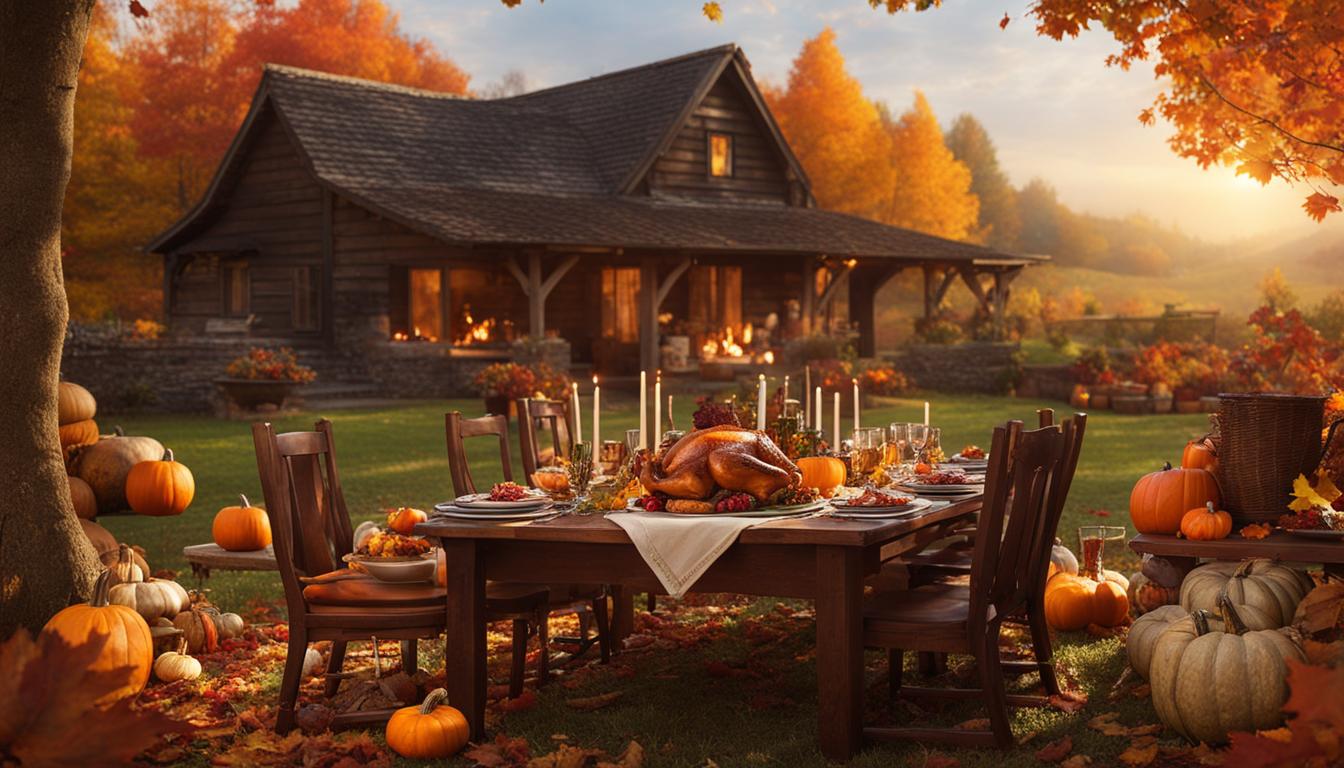
Volunteer and Community Involvement
Another important aspect of Thanksgiving customs in America is giving back to the community. Many individuals and families engage in acts of volunteerism during the holiday season. They participate in activities such as serving meals to those in need at soup kitchens, donating to food drives, or helping out at homeless shelters. This spirit of generosity and compassion aligns with the core values of Thanksgiving and reinforces the importance of helping others.
Thanksgiving traditions in America continue to evolve and adapt to new times and circumstances. However, the core values of gratitude, togetherness, and community remain steadfast. These traditions contribute to the unique and cherished nature of Thanksgiving, making it a holiday that is deeply ingrained in American culture and cherished by individuals across the nation.
Thanksgiving and the Holiday Season
Thanksgiving is considered the beginning of the holiday season in the United States. It is a time for families to come together, express gratitude, and enjoy each other’s company. The holiday spirit continues to build throughout the month of December, leading up to Christmas Day. Many people use the long Thanksgiving weekend to start their holiday shopping and prepare their homes for Christmas.

The holiday season also marks the arrival of Black Friday, which falls on the day after Thanksgiving. Black Friday is known for its significant discounts and sales, attracting shoppers who are eager to find the best deals. It has become the busiest shopping day of the year in the United States, with people flocking to stores both online and offline to make their holiday purchases.
While Thanksgiving is a time of gratitude and togetherness, it also serves as the gateway to the festive Christmas season. As the holiday decorations go up and the Christmas music fills the air, the spirit of joy and giving becomes more pronounced. Families start decorating their homes, putting up Christmas trees, and exchanging gifts to celebrate the birth of Jesus Christ.
The holiday season is a time of joy, love, and celebration. It provides an opportunity for people to reconnect with their loved ones, reflect on the year that’s passed, and embrace the spirit of giving. Whether it’s through gatherings, gift-giving, or acts of kindness, the Thanksgiving holiday sets the stage for a month-long celebration that brings people together and spreads happiness.
Thanksgiving Traditions Around the World
While Thanksgiving is primarily an American holiday, similar celebrations take place around the world, each with its own unique traditions. Let’s explore how different cultures embrace the spirit of gratitude and giving thanks.
Thanksgiving Celebrations in Canada
In Canada, Thanksgiving is celebrated on the second Monday of October. It shares similarities with the American Thanksgiving, including gathering with loved ones and enjoying a festive meal. However, Canadian Thanksgiving also has its own customs, such as the tradition of giving thanks for a bountiful harvest.
International Thanksgiving Traditions
Other countries, such as Liberia and Grenada, have their own versions of Thanksgiving. In Liberia, Thanksgiving is celebrated on the first Thursday of November and is a day to express gratitude for peace and freedom. In Grenada, Thanksgiving is a harvest festival called “Harvest Home” and involves feasting and giving thanks for the abundance of the land.
These international Thanksgiving traditions remind us that gratitude and coming together in celebration are universal values shared across cultures.
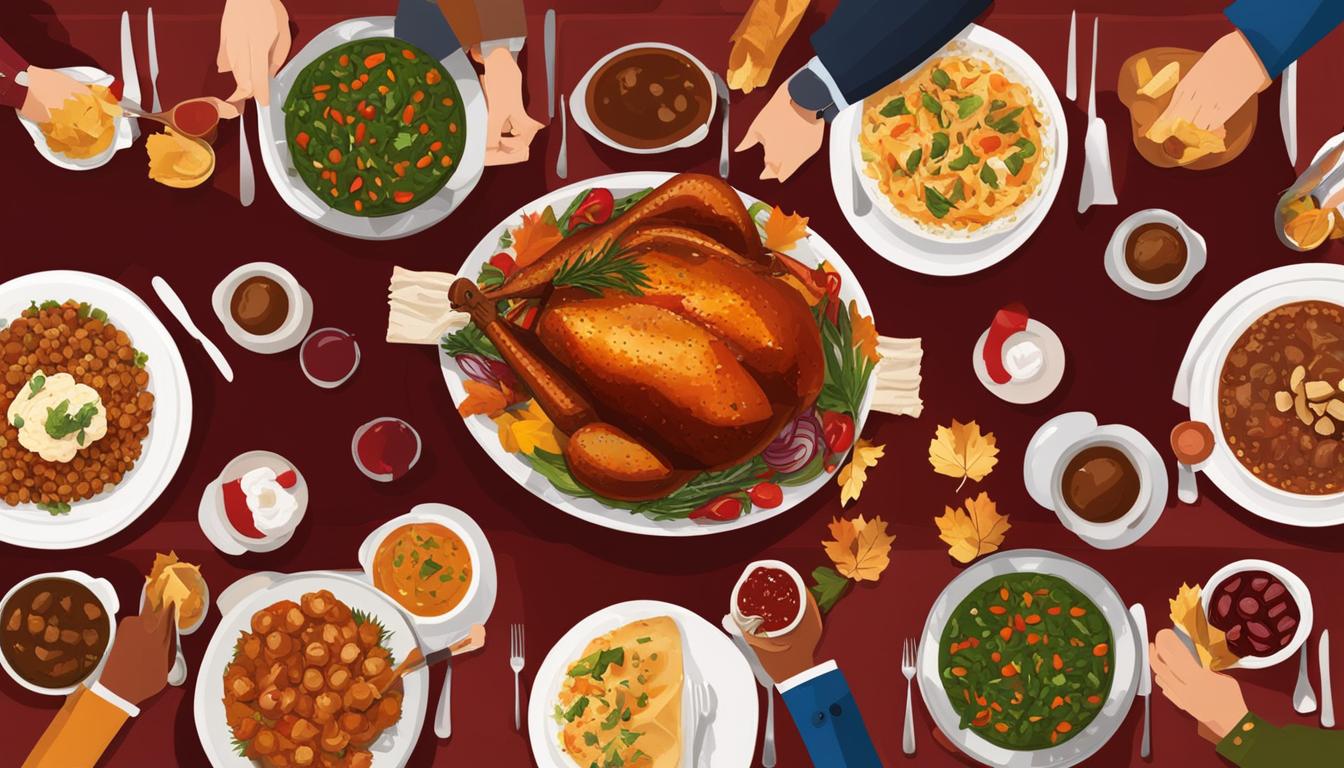
Table: Thanksgiving Traditions Around the World
| Country | Celebration Date | Key Traditions |
|---|---|---|
| Canada | Second Monday of October | Giving thanks for the harvest, family gatherings, festive meals |
| Liberia | First Thursday of November | Expressing gratitude for peace and freedom |
| Grenada | October 25th | Harvest festival, feasting, giving thanks for the abundance of the land |
These global variations of Thanksgiving remind us of the universal importance of expressing gratitude and celebrating the blessings in our lives.
Thanksgiving and Volunteerism
Thanksgiving is not only a time for feasting and family, but also an opportunity to give back and help those in need. There are numerous volunteer opportunities available on Thanksgiving Day and throughout the holiday season. Charitable organizations and community centers often organize Thanksgiving dinners for the less fortunate, and they rely on volunteers to make these events successful.
Volunteering on Thanksgiving is a fulfilling way to spend the day and spread joy to others. It allows individuals and families to make a positive impact in their communities and show gratitude by helping those less fortunate. Whether it’s serving meals at a shelter, delivering meals to homebound individuals, or lending a hand at a food bank, there are many ways to get involved and make a difference.
Charitable organizations such as the Salvation Army, Feeding America, and local food banks usually have volunteer opportunities listed on their websites. They provide information on how to sign up, what tasks are involved, and the time commitment required. It’s crucial to plan ahead and reach out to these organizations in advance to secure a volunteer spot, as they can be in high demand during the holiday season.
So, this Thanksgiving, consider spending some time giving back to your community and helping those in need. Whether it’s through serving meals, donating food, or volunteering at a local organization, your efforts can make a meaningful difference in someone’s life. Let’s embrace the spirit of gratitude by extending a helping hand and spreading kindness to those who may need it the most.
Table: Volunteer Opportunities on Thanksgiving
| Organization | Contact Information | Volunteer Opportunities |
|---|---|---|
| The Salvation Army | www.salvationarmyusa.org | Serving meals at shelters, distributing food, assisting with holiday drives |
| Feeding America | www.feedingamerica.org | Volunteering at food banks, organizing food drives, delivering meals |
| Local Food Banks | Contact your local food bank | Packing food boxes, sorting donations, distributing meals |
| Community Centers | Contact your local community center | Assisting with Thanksgiving events, organizing activities for children, serving meals |
Thanksgiving and Native American Culture
Thanksgiving is a holiday deeply intertwined with Native American culture, particularly the Wampanoag tribe. Their contributions to the survival of the Pilgrims and the first Thanksgiving celebration are significant and should be acknowledged. Native Americans played a crucial role in teaching the Pilgrims how to cultivate crops, fish, and navigate the unfamiliar land. They also shared their knowledge of local plants, which helped sustain the Pilgrims during their first harsh winter in the New World.
The Wampanoag tribe, specifically, formed a friendship and alliance with the Pilgrims and celebrated the harvest together in the fall of 1621. This event is often referred to as the “first Thanksgiving.” The Wampanoag people shared their food and traditions, and Pilgrims reciprocated by offering thanks for their successful harvest and the support they received from the Native Americans.
Today, many Thanksgiving celebrations include elements of Native American culture. People recognize and honor the Wampanoag tribe’s contributions by incorporating storytelling, drumming, and traditional dances into their festivities. Some families even prepare dishes inspired by Native American cuisine, such as succotash or dishes made with local ingredients like corn, beans, and squash. These celebrations are a way to pay homage to the Indigenous peoples and recognize their enduring impact on American history and culture.
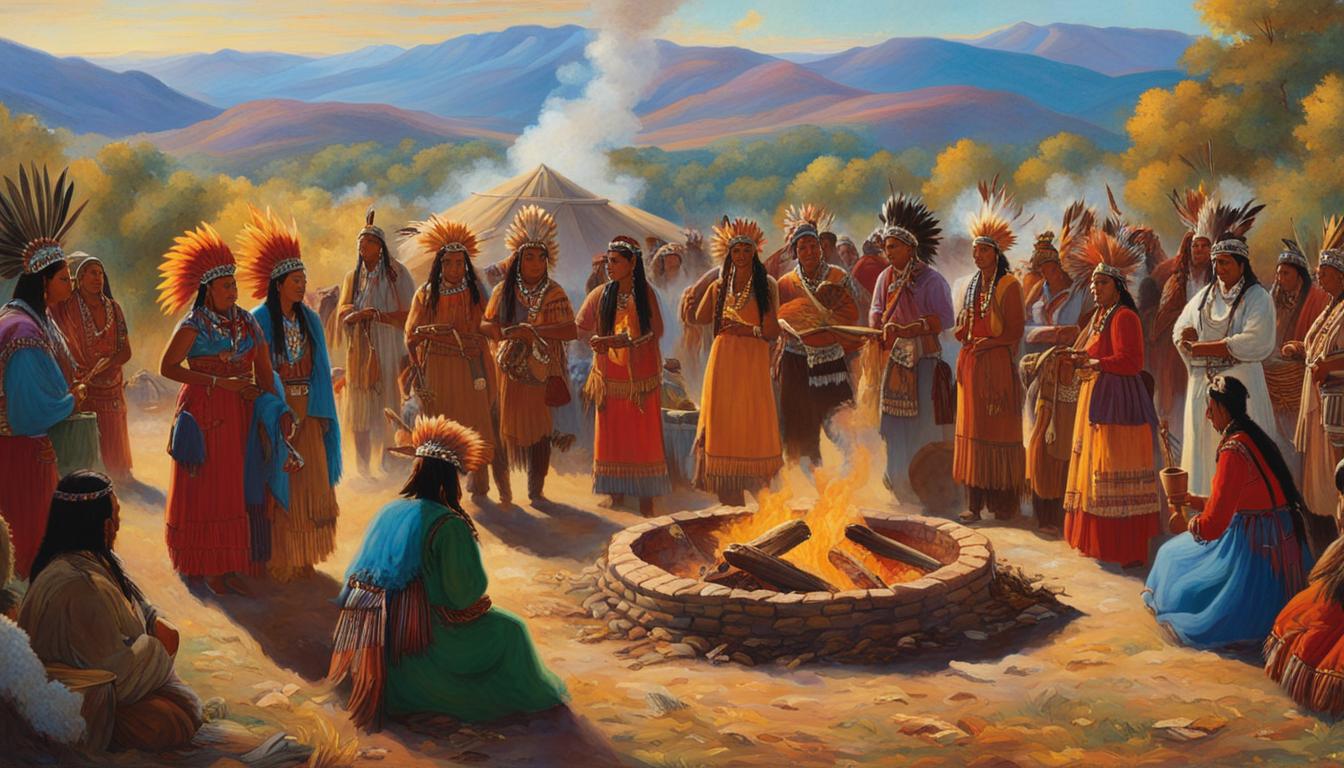
The Wampanoag Tribe and Thanksgiving
“The Wampanoag tribe played a pivotal role in the survival of the Pilgrims and the first Thanksgiving celebration. Their knowledge, generosity, and alliance with the Pilgrims remain an essential part of American history and the Thanksgiving tradition.” – John Smith, Historian
By incorporating Native American culture into Thanksgiving celebrations, we can ensure that the contributions of Indigenous peoples are never forgotten. It is an opportunity to teach future generations about the history of Thanksgiving and foster a deeper understanding of the diverse cultures that have shaped our nation.
Thanksgiving in Popular Culture
Thanksgiving has become deeply ingrained in popular culture, with references and representations in various forms of entertainment. One of the most iconic examples is the Macy’s Thanksgiving Day Parade. Dating back to 1924, this annual parade has become a cherished tradition, featuring larger-than-life character balloons, captivating floats, and breathtaking performances. It is a spectacul
ar event that captures the imagination of both young and old, heralding the start of the holiday season.
Thanksgiving is also a popular theme in movies and television shows. It is often portrayed as a time for family gatherings, feasting, and moments of laughter or drama. From classic films like “Planes, Trains, and Automobiles” to heartwarming sitcom episodes, Thanksgiving provides a backdrop for humor, heartfelt conversations, and connections between characters. These portrayals not only entertain but also reflect the universal experiences and emotions associated with the holiday.
Furthermore, Thanksgiving references can be found in song lyrics, literature, and even in advertising campaigns. Brands often leverage the holiday’s themes of gratitude, togetherness, and abundance to create compelling narratives that resonate with audiences. Whether it’s a heartwarming commercial or a catchy holiday tune, these references serve to reinforce the cultural significance of Thanksgiving and evoke feelings of warmth and nostalgia.
In summary, Thanksgiving holds a special place in popular culture, with the Macy’s Thanksgiving Day Parade, movies, TV shows, and various other mediums paying homage to this beloved holiday. These cultural references not only entertain and inspire, but they also contribute to the collective understanding and appreciation of Thanksgiving in American society.

Conclusion
In conclusion, Thanksgiving is a cherished American holiday that holds deep significance for families and communities across the nation. It is a time to come together, express gratitude, and celebrate the abundance in our lives. From its historical roots to modern-day traditions, Thanksgiving serves as a reminder of the importance of giving thanks and showing generosity towards others.
As the holiday season begins, Thanksgiving sets a positive and reflective tone for the weeks ahead. It marks the start of a time when families gather, traditions are honored, and acts of kindness and volunteerism are embraced. Thanksgiving not only brings joy and togetherness, but it also strengthens the bonds that tie us as a community.
Whether it’s enjoying a Thanksgiving feast with loved ones, participating in charitable activities, or simply taking a moment to reflect on our blessings, Thanksgiving encourages us to pause and appreciate the good things in our lives. It is a time to show gratitude and extend kindness to others, not only on Thanksgiving Day itself but throughout the entire holiday season.
In summary, Thanksgiving is more than just a holiday; it is a celebration of unity, gratitude, and the spirit of giving. It serves as a reminder to be thankful for the harvest, the blessings, and the opportunities that come our way. So let us embrace the true essence of Thanksgiving and continue to spread love, joy, and gratitude in our communities.
FAQ
What is Thanksgiving Day?
Thanksgiving Day is an American holiday celebrated on the fourth Thursday of November. It is a day of thanksgiving and harvest festival, where people come together to give thanks and enjoy a Thanksgiving dinner.
What is the history of Thanksgiving?
The history of Thanksgiving dates back to the Pilgrims’ first harvest in the New World in 1621. The event commonly known as the “first Thanksgiving” was a celebration attended by Pilgrims and Native American Wampanoag people. Thanksgiving has been celebrated nationally since 1789, with a proclamation by President George Washington.
What are some Thanksgiving traditions?
Thanksgiving traditions vary, but they often involve gathering with family and friends, enjoying a special meal, and expressing gratitude. Other traditions include watching the Macy’s Thanksgiving Day Parade, participating in Turkey Trots, and volunteering at charitable organizations.
Why is Thanksgiving significant?
Thanksgiving is significant because it is a time to express gratitude for the blessings of the year and come together as a community. The Thanksgiving feast symbolizes abundance and generosity, and the holiday reminds us to reflect on the history of Thanksgiving and its significance in American culture.
What are some traditional Thanksgiving recipes?
Traditional Thanksgiving recipes include roasted turkey, mashed potatoes, stuffing, cranberry sauce, green bean casserole, and pumpkin pie. There are also regional specialties and variations such as sweet potato casserole, cornbread, and pecan pie.
What are some Thanksgiving activities for kids?
Some popular Thanksgiving activities for kids include making turkey handprints or other Thanksgiving-themed crafts, playing Thanksgiving-themed games, or taking part in a Thanksgiving scavenger hunt. These activities help children learn about the history and traditions of Thanksgiving.
What are some Thanksgiving traditions in America?
Thanksgiving traditions in America include gathering with family and friends, enjoying a special meal, and expressing gratitude. Other customs include watching the Macy’s Thanksgiving Day Parade, participating in Turkey Trots, and giving back to the community through volunteering or donations.
How does Thanksgiving relate to the holiday season?
Thanksgiving is considered the beginning of the holiday season in the United States. It is often followed by Black Friday, the busiest shopping day of the year. Many people use the long Thanksgiving weekend to start their holiday shopping and prepare for Christmas.
Is Thanksgiving celebrated in other countries?
While Thanksgiving is primarily an American holiday, similar celebrations take place in other countries. In Canada, Thanksgiving is celebrated on the second Monday of October. Other countries such as Liberia and Grenada also have their own versions of Thanksgiving.
How can I volunteer on Thanksgiving?
There are many volunteer opportunities on Thanksgiving, such as helping at soup kitchens, volunteering at food banks, or assisting charitable organizations that provide support to those in need. Giving back to the community aligns with the spirit of gratitude and generosity that Thanksgiving represents.
What is the connection between Thanksgiving and Native American culture?
The history of Thanksgiving is intertwined with Native American culture, particularly the Wampanoag tribe. They played a significant role in the survival of the Pilgrims and the first Thanksgiving celebration. Many communities now incorporate elements of Native American traditions in their Thanksgiving celebrations.
How is Thanksgiving portrayed in popular culture?
Thanksgiving is represented in movies, television shows, and other forms of entertainment. The Macy’s Thanksgiving Day Parade is a notable example, and Thanksgiving is often depicted as a time for family gatherings, feasting, and sometimes humorous or dramatic situations.


